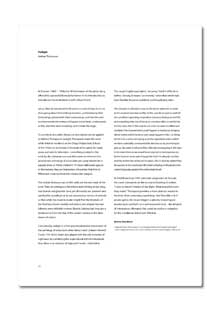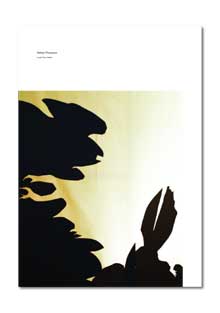 |
|||||||||
|
|
| ...Publications: Annual | ...The Physics Room Annual 2003 | ||||||||||||||
|
Twilight M.R.James (1862 - 1936),the British master of the ghost story, offered his successful formula for horror in his introduction to Sheridan Le Fanu’s Madame Crowl’s Ghost (1923): Let us, then, be introduced to the actors in a placid way; let us see them going about their ordinary business , undisturbed by their forebodings, pleased with their surroundings, and into this calm environment let the ominous thing put out its head , unobtrusively at first, and then more insistently, until it holds the stage. To an extent, this rather theatrical description can be applied to Nathan Thompson’s twilight. Thompson made the work while Artist-in-residence at the Otago Polytechnic School of Art (‘Olam’ to its friends). Previously in his career he made props and sets for television - something evoked in this work by the elaborate cut-outs that seem to reference the proscenium and wings of a macabre-yet-camp theatre for a puppet show or 1950s children’s TV show Halloween special. In themselves, they are featureless silhouettes that hint a t Wildwood creatures from the crepuscular margins. The sinister shadows cast on the walls are the real meat of the work. They are ambiguous Rorschach tests hinting at bat wing , tree branch and ghoulish claw, yet ultimately too ‘pretend’ and sanitised to actually prod at our unconscious terrors. It reminds us that while the modern reader might find the fairytales of the Brothers Grimm morbid and violent, the original German folktales were infinitely moreso. Electric lighting has long since distanced us from the fear of the unseen lurking in the dark dream of nature. Conceptually, twilight is a Post - pop installationist descendant of the paintings of Swiss - born artist Henry Fuseli (Johann Heinrich Füssli ,1741 - 1825 ) . Fuseli also played with the safe monsters of nightmare by combining the supernatural with the theatrical. Also, there is an element of Sigmund Freud’s Unheimlich. The rough English equivalent, "uncanny," itself is difficult to define. Literally, it means "un-homely," when that which had been familiar becomes suddenly and inexplicably alien: The situation is altered as soon as the writer pretends to move in the world of common reality. In this case he accepts as well all the conditions operating to produce uncanny feelings in real life; and everything that would have an uncanny effect in reality has it in his story. But in this case he can even increase his effect and multiply it far beyond what could happen in reality, by bringing about events which never or very rarely happen in fact. In doing this he is in a sense betraying us to the superstitiousness which we have ostensibly surmounted; he deceives us by promising to give us the sober truth, and then after all overstepping it. We react to his inventions as we would have reacted to real experiences; by the time we have seen through his trick it is already too late and the author has achieved his object. But it must be added that his success is not unalloyed. We retain a feeling of dissatisfaction, a kind of grudge against the attempted deceit . 1 In Todd Browning’s 1931 cinematic adaptation of Dracula, the count comments on the nocturnal howling of wolves: "Listen to them! Children of the Night. What beautiful music they make!" Thompson provides a more abstract version in the form of an unnerving sound loop. And then, like a lo-fi arcade game, the viewer triggers a ghostly shaped space-invader back and forth on a wall-mounted track - the simplest of interactions. Ultimately this could be read as a metaphor for the installation: kitsch, but effective. Andrew Paul Wood 1 Sigmund Freud, "The Uncanny," in The Standard Edition of the Complete Psychological Works of Sigmund Freud, ed. & trs. James Strachey, vol. XVII (London: Hogarth, 1953), p.252. View Twilight - Essay by Andrew Paul Wood as a PDF This essay originally appeared in The Physics Room Annual 2003 Order your copy today from The Physics Room ! Related 23 September - 18 October 2003
|
||||||||||||||


